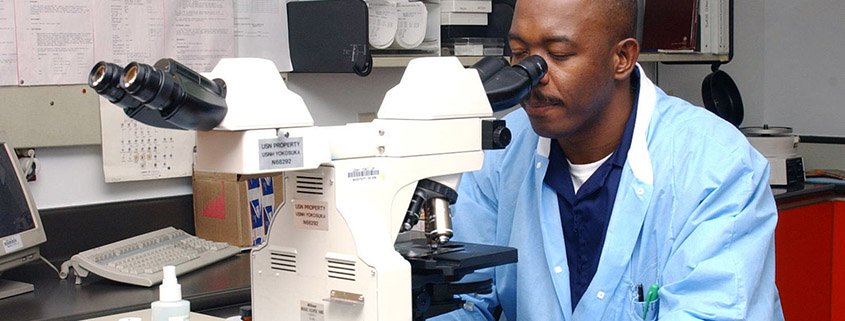Cytology vs. biopsy: Comparisons of accuracy [Part 2]
Andrew S. Loar, DVM, DACVIM (Oncology and Internal Medicine)
Posted on 2017-09-19 in Clinical pathology
In our previous blog post, interpretive issues associated with the evaluation of accuracy of cytology were examined. In the literature, investigators have examined the diagnostic accuracy of cytologic analyses, compared to the presumptive gold standard of histopathology, for the evaluation of tissues in a number of selected anatomical locations. Various studies have addressed lesions identified from the skeleton, gastrointestinal and respiratory tracts, subcutaneous and dermal sites, liver, spleen, lymph nodes and prostate gland. For each site, the diagnostic sensitivity, specificity, and accuracy of cytology will be described, as well as other significant factors relevant to the correlation of microscopic diagnosis and disease within each of these systems.
Bony lesions
Compared to diagnoses derived from histologic analysis, using incisional (core) and/or excisional (generally via amputation) biopsy, cytology findings from radiographically identified bone lesions are variably accurate, particularly dependent on whether the process is neoplastic versus inflammatory. In several studies of more than 50 canine bony lesions, the vast majority of which were in long bones, cytologic evaluations were in agreement with biopsy results in approximately 70% of the cases. It is noteworthy that incisional biopsy results were in agreement with excisional biopsy findings in only 54% of the cases; examination of excisional bone specimens is considered the reference/gold standard. However, there was marked variation in the accuracy of cytology for identification of neoplastic compared with non-neoplastic conditions; more than 90% of the cytologic diagnoses of bony tumors were confirmed via biopsy, while less than 30% of cases with cytologic findings of non-neoplastic (generally inflammatory) disease were verified on histopathology the majority of these discordant cases were confirmed via biopsy to be neoplastic.
In summary, using needle aspirates of lytic/proliferative skeletal lesion, less than 10% of all cytologic diagnoses of neoplasia are shown to be non-neoplastic (low false positive rate), while more than 70% of all cases without cytologic evidence of neoplasia are ultimately confirmed to be tumor (high false negative rate). The factor that most significantly influences diagnostic accuracy is the overall cellularity of the cytologic specimen; samples with low to poor cellularity, which arguably could be interpreted as nondiagnostic, were most frequently associated with a poor correlation to subsequent biopsy analysis. In practical terms, the clinician can generally expect that a cytologic diagnosis of bony neoplasia from a highly cellular aspirate is accurate and reliable; in contrast, the majority of cytologic diagnoses of non-neoplastic (inflammatory) bony disease, particularly from samples of low cellularity, should be re-aspirated or biopsied to verify tumor.
Gastrointestinal tumors
Compared to diagnoses using histology, generally from full thickness or endoscopically derived biopsies, cytology findings from gastrointestinal tumors show impressive accuracy. In several studies of more than 100 canine and feline gastrointestinal tumors, cytologic evaluations of samples with acceptable cellularity were in agreement with biopsy results in nearly 90% of the cases. The highest levels of agreement, with specificities and sensitivities of virtually 100%, were from cytology specimens representing impression smears of the biopsy samples, many of which were submitted as intraoperative slides.
Tumor types in these studies included gastrointestinal lymphoma, carcinoma and mesenchymal neoplasia (leiomyoma and leiomyosarcoma). As stated above, specificity of cytology evaluation from fine needle aspirates of all tumors was nearly 100%. However the rate of false negative cytology results (sensitivity) varied by cell type; the highest sensitivity was found in the cytologic diagnosis of lymphoma (71%), followed by gastrointestinal carcinoma (63%) and mesenchymal tumors (44%). There has been no accuracy study published for non-neoplastic gastrointestinal lesions. It is noteworthy that investigations of gastrointestinal biopsy results have showed significant variation in diagnoses when more than one anatomic pathologist reviews the specimens; one study found interobserver disagreement associated with more than 50% of intestinal lesions examined. Moreover, regarding the proposed gold standard for verification of gastrointestinal disease, many dispute the comparative accuracy of biopsy results derived from full thickness surgical excision versus those obtained endoscopically. It is therefore critical that endoscopic biopsies are read by pathologists skilled in endoscopic histopathology.
Image credit: Modified from U.S. Navy photo by Tom Watanabe. [Public domain], via Wikimedia Commons
About the author
|




